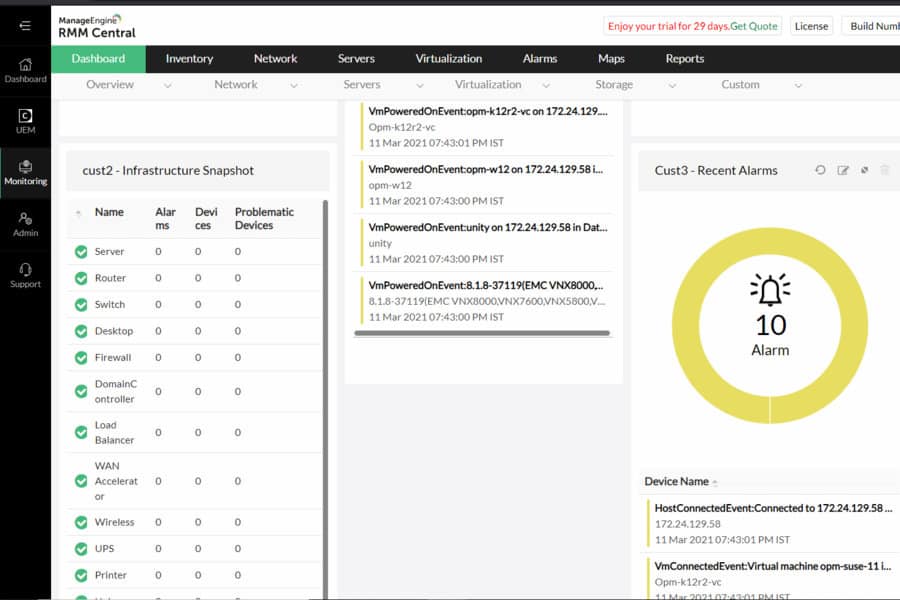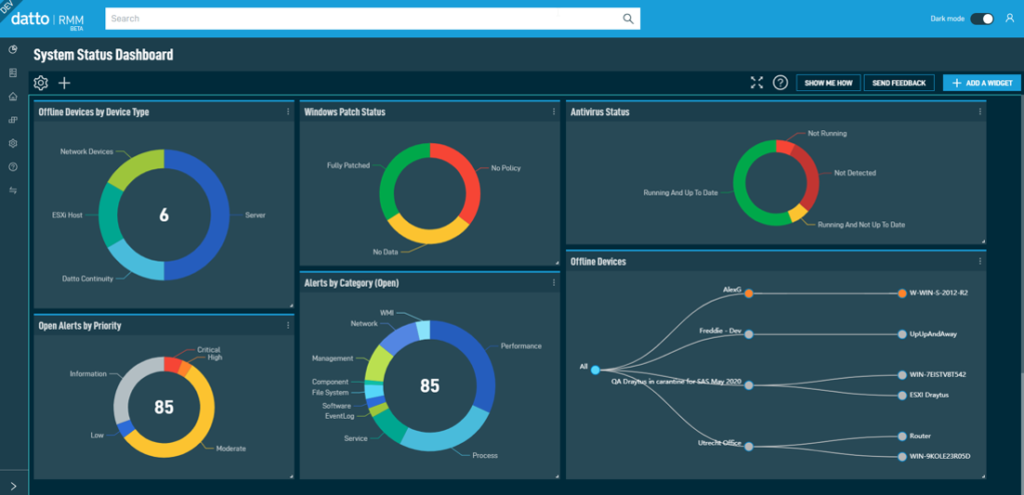Comparing top RMM platforms for managed service providers is crucial for MSPs seeking to optimize efficiency and security. The right RMM solution can significantly impact an MSP’s ability to deliver exceptional service, scale operations, and boost profitability. This deep dive explores key features, security capabilities, and integration options of leading platforms, helping you choose the perfect fit for your business needs.
We’ll break down the pros and cons, pricing models, and real-world experiences to guide you toward making an informed decision.
From remote control and patch management to robust security monitoring and automation workflows, choosing the right RMM platform is a game-changer. This guide analyzes leading contenders, comparing their strengths and weaknesses across a range of critical factors. We’ll examine everything from user-friendliness and scalability to the level of technical support provided, ensuring you have all the information you need to select the ideal RMM solution for your MSP.
Key Features Comparison

Choosing the right RMM platform is crucial for managed service providers (MSPs) aiming for efficiency and profitability. This comparison focuses on five leading platforms, highlighting their core features, user experience, and pricing models to aid in your decision-making process. We’ll delve into the specifics of each platform, allowing you to weigh the pros and cons before committing.
Choosing the right RMM platform is crucial for managed service providers, impacting everything from ticket management to client satisfaction. Effective client management, however, extends beyond the technical; investing in effective CRM training programs for sales and customer service teams is equally vital for maximizing your RMM’s potential. Ultimately, a streamlined workflow, powered by both robust RMM and skilled CRM users, translates to a more profitable and efficient business.
RMM Platform Feature Comparison
The following table compares five leading RMM platforms across key features. Note that specific features and capabilities can change over time, so it’s always recommended to check the vendor’s website for the most up-to-date information.
| Platform Name | Remote Control Capabilities | Patch Management Features | Security Monitoring & Alerting |
|---|---|---|---|
| ConnectWise Automate | Robust remote control with scripting capabilities and session recording. | Comprehensive patch management with automated patching and vulnerability scanning. | Real-time security monitoring with customizable alerts for various threats. |
| Datto RMM | Secure remote control with features like unattended access and multi-monitor support. | Automated patch management with reporting and exception handling. | Advanced security monitoring with endpoint detection and response (EDR) capabilities. |
| NinjaOne | Intuitive remote control with screen sharing and file transfer. | Automated patch management with flexible scheduling and prioritization. | Integrated security monitoring with vulnerability assessments and threat detection. |
| Atera | User-friendly remote control with chat and collaboration features. | Automated patch management with customizable rules and reporting. | Security monitoring with alerts and remediation options. |
| Autotask PSA (now Datto Autotask) | Remote control integrated with PSA functionality for streamlined workflow. | Patch management capabilities integrated within the PSA platform. | Security monitoring integrated with other PSA features for comprehensive management. |
User Interface and Ease of Use
Each platform offers a unique user interface. ConnectWise Automate, while powerful, can have a steeper learning curve for new users. NinjaOne and Atera are often praised for their intuitive and user-friendly interfaces, making them easier to adopt and use. Datto RMM strikes a balance between power and usability, while Autotask PSA, being a comprehensive PSA solution, may require more time to master its integrated RMM features.
Choosing the right RMM platform is crucial for managed service providers, impacting efficiency and client satisfaction. Smart decisions, however, require more than just technical specs; understanding your client base is key, which is why leveraging data is essential. To truly optimize your RMM strategy, check out this insightful article on using CRM data analytics to drive better business decisions to gain valuable insights for better informed choices when comparing top RMM platforms.
Ultimately, ease of use is subjective and depends on individual preferences and technical expertise.
Pricing Models and Value Proposition
Pricing models vary significantly. Many platforms use a per-device or per-technician licensing model, with additional costs for advanced features or add-ons. For example, ConnectWise Automate typically employs a per-technician model, while Atera offers a per-device model with tiered pricing based on features. Datto RMM and NinjaOne also utilize various pricing tiers to accommodate different MSP sizes and needs.
The value proposition of each platform hinges on its feature set, scalability, and overall cost-effectiveness relative to the MSP’s specific requirements and business model. A thorough cost-benefit analysis is essential before making a selection.
Integration and Automation Capabilities: Comparing Top RMM Platforms For Managed Service Providers

Choosing the right RMM platform hinges significantly on its integration and automation capabilities. These features directly impact an MSP’s operational efficiency, reducing manual tasks and freeing up technicians to focus on higher-value work. A robust platform seamlessly integrates with existing tools, streamlining workflows and minimizing the risk of errors associated with manual data entry and transfer. Automation, meanwhile, dramatically improves response times and reduces operational costs.The integration capabilities of leading RMM platforms vary considerably.
Understanding these differences is crucial for MSPs looking to optimize their technology stack. Effective automation features go beyond simple scripting; they should offer intuitive workflows and robust reporting to track performance and identify areas for improvement.
RMM Platform Integrations with Common MSP Tools
The ability to seamlessly integrate with other essential MSP tools is paramount. Leading RMM platforms typically offer robust APIs and pre-built integrations with popular PSA (Professional Services Automation) software like Autotask, ConnectWise Manage, and Datto Autotask. Similarly, strong integrations with ticketing systems (e.g., Zendesk, Freshdesk) and backup solutions (e.g., Datto, Veeam) are crucial for a unified and efficient workflow.
For example, an integration with a PSA system allows for automatic ticket creation upon detection of an alert within the RMM, streamlining the incident response process. A well-integrated backup solution enables automated backups and restores, minimizing downtime in the event of a system failure. Lack of robust integrations often forces manual data entry and transfer, creating bottlenecks and increasing the risk of human error.
Automation Features and Their Impact on MSP Efficiency
Automation features are the backbone of efficient RMM operations. These features significantly reduce manual tasks, allowing technicians to focus on more complex issues. For example, automated patch management prevents vulnerabilities and reduces the risk of security breaches. Automated device discovery and onboarding streamlines the process of adding new clients, saving valuable time and resources. Remote control and scripting capabilities enable technicians to resolve issues remotely, reducing the need for on-site visits and improving response times.
Automated reporting provides valuable insights into the health of managed systems, allowing MSPs to proactively address potential problems before they impact clients. This proactive approach, enabled by automation, is a key differentiator in today’s competitive MSP landscape.
Examples of Automation Workflows, Comparing top RMM platforms for managed service providers
Consider these examples of automated workflows achievable with leading RMM platforms:
- Automated Patch Management: The platform automatically scans devices for missing patches, downloads and installs them, and then generates reports on the success or failure of the updates. This eliminates the manual process of checking for and applying patches, reducing the risk of security vulnerabilities.
- Automated Alerting and Ticketing: When a critical event occurs (e.g., high CPU usage, disk space nearing capacity), the platform automatically generates an alert and creates a ticket within the MSP’s PSA system, assigning it to the appropriate technician. This ensures that issues are addressed promptly and efficiently.
- Automated Backup and Recovery: The RMM platform integrates with a backup solution to schedule and execute regular backups. In case of a system failure, the platform can initiate an automated recovery process, minimizing downtime for the client.
- Automated Onboarding of New Clients: The platform automatically discovers devices on the client’s network, configures monitoring agents, and sets up automated reporting. This reduces the time and effort required to onboard new clients.
Implementing these automated workflows leads to significant cost savings by reducing labor hours, improving service delivery, and enhancing client satisfaction. The return on investment (ROI) from a well-integrated and automated RMM platform is substantial for any MSP.
User Experience and Training

Choosing the right RMM platform isn’t just about features; it’s about how easily your team can adopt and utilize it. A smooth user experience and comprehensive training resources are crucial for maximizing efficiency and minimizing frustration. This section dives into the user experience and training aspects of leading RMM platforms, helping you make an informed decision.The user experience of an RMM platform significantly impacts its overall effectiveness.
A clunky interface or confusing workflow can lead to wasted time and reduced productivity. Conversely, an intuitive and well-designed platform empowers your team to manage endpoints efficiently and effectively. This includes ease of navigation, clear task organization, and readily accessible support. Similarly, robust training resources are vital for ensuring that your team can quickly become proficient in using the platform’s capabilities.
Onboarding and User Interface Comparison
The onboarding process varies significantly across RMM platforms. Some offer guided tours and interactive tutorials, while others rely heavily on extensive documentation. For instance, ConnectWise Automate might present a more gradual learning curve with its modular design, allowing users to focus on specific aspects at a time. On the other hand, a platform like Datto RMM may offer a more comprehensive, albeit potentially steeper, initial learning curve due to its extensive feature set.
Ease of navigation, intuitive dashboards, and customizable views are key differentiators. A clean, uncluttered interface contributes to a positive user experience, allowing technicians to quickly locate and manage critical information. Platforms with poor UI design often lead to decreased efficiency and increased user frustration.
Training Resources Available
Comprehensive training resources are essential for successful RMM platform adoption. Most providers offer a combination of resources, including:
- Extensive Documentation: Detailed user manuals, knowledge bases, and FAQs are common. The quality and comprehensiveness of these resources vary widely.
- Webinars and Online Tutorials: Many platforms offer recorded webinars and step-by-step video tutorials covering various aspects of the platform.
- In-Person Training: Some vendors offer in-person training sessions, providing hands-on experience and personalized guidance. This is often an additional cost.
- Dedicated Support Teams: Direct access to support staff via phone, email, or chat is crucial for resolving issues and answering questions.
- Community Forums: Active online communities can provide a valuable resource for peer-to-peer support and troubleshooting.
The availability and quality of these resources significantly influence the ease of onboarding and the overall user experience. For example, a platform with excellent video tutorials and a supportive community forum can greatly reduce the learning curve compared to one with only limited documentation.
Key User Experience Aspects Influencing RMM Platform Choice
The decision of which RMM platform to adopt should heavily consider these key user experience factors:
- Intuitive Interface: A clean, easy-to-navigate interface significantly impacts productivity.
- Customizability: The ability to personalize dashboards and workflows to match individual needs and preferences.
- Reporting and Analytics: Clear and concise reporting capabilities are essential for monitoring performance and identifying areas for improvement.
- Accessibility: The platform should be accessible across various devices and operating systems.
- Responsiveness: A fast and responsive platform ensures efficient workflow and minimizes downtime.
- Ease of Onboarding: A streamlined onboarding process reduces the time and effort required to get started.
- Comprehensive Training: Access to high-quality training resources, including documentation, webinars, and tutorials.
By carefully evaluating these aspects, MSPs can select an RMM platform that not only meets their technical needs but also enhances the productivity and satisfaction of their teams.